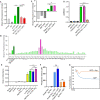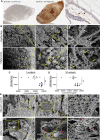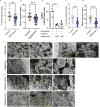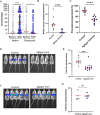This is a preprint.
Anopheles salivary apyrase regulates blood meal hemostasis and drives malaria parasite transmission
- PMID: 37292610
- PMCID: PMC10245845
- DOI: 10.1101/2023.05.22.541827
Anopheles salivary apyrase regulates blood meal hemostasis and drives malaria parasite transmission
Update in
-
Mosquito salivary apyrase regulates blood meal hemostasis and facilitates malaria parasite transmission.Nat Commun. 2024 Sep 18;15(1):8194. doi: 10.1038/s41467-024-52502-3. Nat Commun. 2024. PMID: 39294191 Free PMC article.
Abstract
Mosquito salivary proteins play a crucial role in regulating hemostatic responses at the bite site during blood feeding. In this study, we investigate the function of Anopheles gambiae salivary apyrase (AgApyrase) in Plasmodium transmission. Our results demonstrate that salivary apyrase interacts with and activates tissue plasminogen activator, facilitating the conversion of plasminogen to plasmin, a human protein previously shown to be required for Plasmodium transmission. Microscopy imaging shows that mosquitoes ingest a substantial amount of apyrase during blood feeding which reduces coagulation in the blood meal by enhancing fibrin degradation and inhibiting platelet aggregation. Supplementation of Plasmodium infected blood with apyrase significantly enhanced Plasmodium infection in the mosquito midgut. In contrast, AgApyrase immunization inhibited Plasmodium mosquito infection and sporozoite transmission. This study highlights a pivotal role for mosquito salivary apyrase for regulation of hemostasis in the mosquito blood meal and for Plasmodium transmission to mosquitoes and to the mammal host, underscoring the potential for new strategies to prevent malaria transmission.
Conflict of interest statement
Competing interests: All data are available in the manuscript or the supplementary materials.
Figures




Similar articles
-
Mosquito salivary apyrase regulates blood meal hemostasis and facilitates malaria parasite transmission.Nat Commun. 2024 Sep 18;15(1):8194. doi: 10.1038/s41467-024-52502-3. Nat Commun. 2024. PMID: 39294191 Free PMC article.
-
Malaria load affects the activity of mosquito salivary apyrase.J Insect Physiol. 2019 Jul;116:10-16. doi: 10.1016/j.jinsphys.2019.04.003. Epub 2019 Apr 12. J Insect Physiol. 2019. PMID: 30986373
-
Additional Feeding Reveals Differences in Immune Recognition and Growth of Plasmodium Parasites in the Mosquito Host.mSphere. 2021 Mar 31;6(2):e00136-21. doi: 10.1128/mSphere.00136-21. mSphere. 2021. PMID: 33789941 Free PMC article.
-
Malaria parasite development in mosquitoes.Annu Rev Entomol. 1998;43:519-43. doi: 10.1146/annurev.ento.43.1.519. Annu Rev Entomol. 1998. PMID: 9444756 Review.
-
Malaria: influence of Anopheles mosquito saliva on Plasmodium infection.Trends Immunol. 2023 Apr;44(4):256-265. doi: 10.1016/j.it.2023.02.005. Epub 2023 Mar 22. Trends Immunol. 2023. PMID: 36964020 Free PMC article. Review.
Cited by
-
ABE8e Corrects Pax6-Aniridic Variant in Humanized Mouse ESCs and via LNPs in Ex Vivo Cortical Neurons.Ophthalmol Ther. 2023 Aug;12(4):2049-2068. doi: 10.1007/s40123-023-00729-6. Epub 2023 May 20. Ophthalmol Ther. 2023. PMID: 37210469 Free PMC article.
References
-
- WHO, World malaria report 2022. 2022.
Publication types
LinkOut - more resources
Full Text Sources
